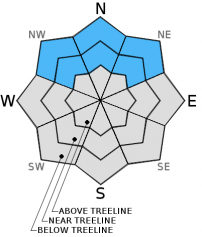| Monday | Monday Night | Tuesday | |
|---|---|---|---|
| Weather: | Partly cloudy | Partly cloudy with cloud cover increasing overnight | Mostly cloudy with some clearing throughout the day |
| Temperatures: | 46 to 51 deg. F. | 32 to 39 deg. F. | 44 to 49 deg. F. |
| Mid Slope Winds: | Variable | Southwest | Variable |
| Wind Speed: | Light | 10-15 mph | Light |
| Expected snowfall: | 0 | 0 | 0 |
| Monday | Monday Night | Tuesday | |
|---|---|---|---|
| Weather: | Partly cloudy | Partly cloudy with cloud cover increasing overnight | Mostly cloudy with some clearing throughout the day |
| Temperatures: | 41 to 48 deg. F. | 29 to 39 deg. F. | 39 to 46 deg. F. |
| Ridge Top Winds: | Southwest | Southwest | Southwest |
| Wind Speed: | 15 to 20 mph with gusts to 30 mph | 15 to 25 mph with gusts to 35 mph | 15 to 25 mph with gusts to 35 mph |
| Expected snowfall: | 0 | 0 | 0 |

























